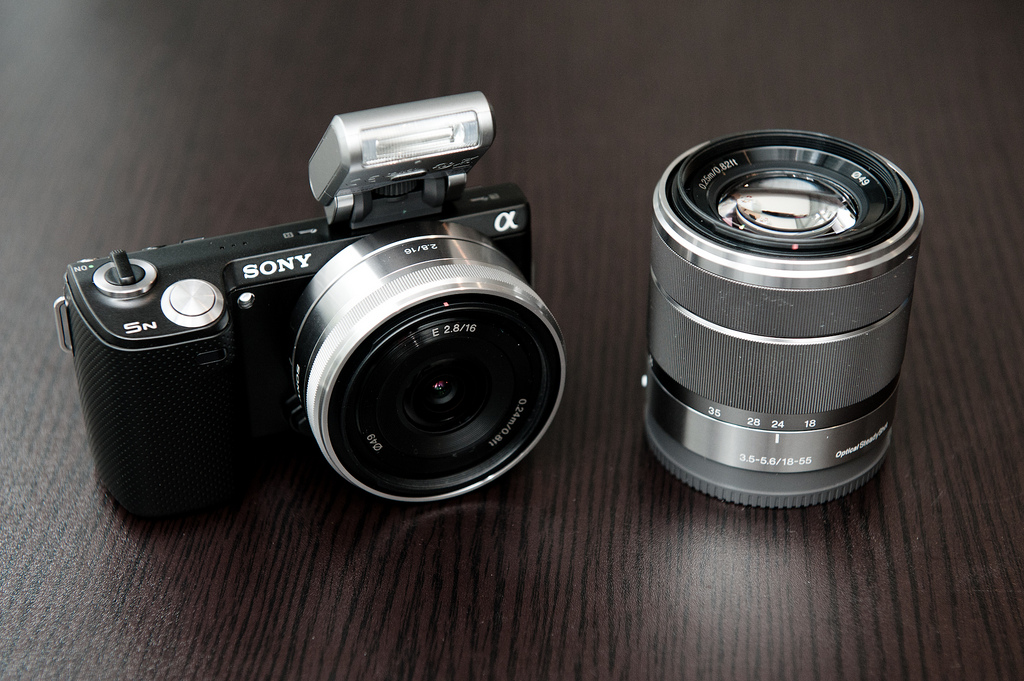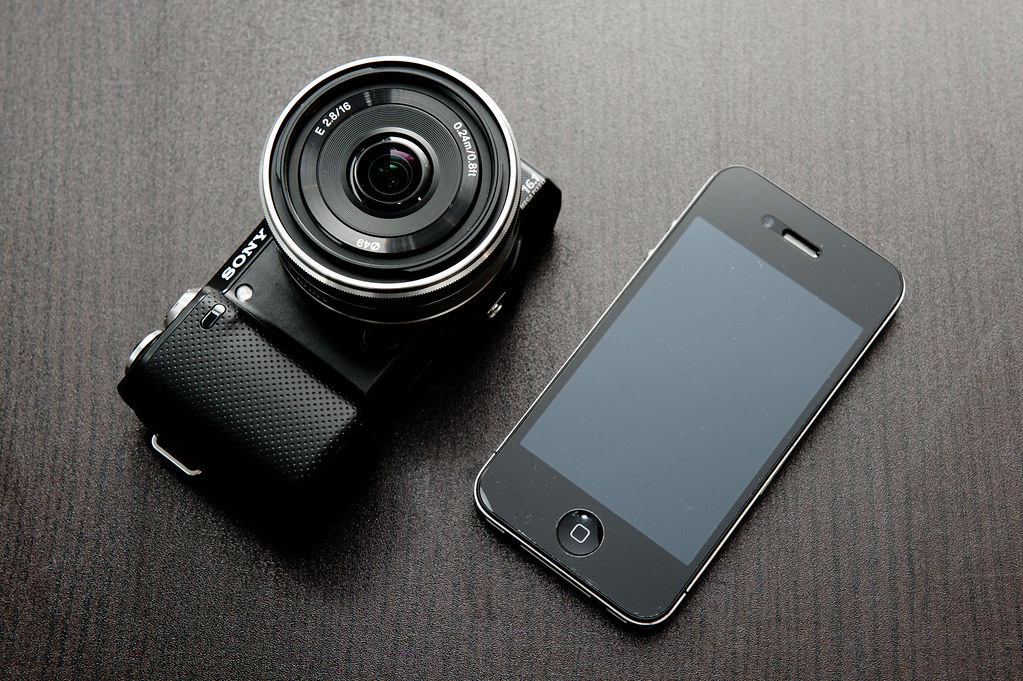If you like this post, help us share it
Sony first introduced their NEX interchangeable lens system NEX-3 and NEX-5 back in May, 2010.The NEX system became extremely popular simply because it had fitted an APS-C size sensor in a very compact body. The APS-C sensor is slight bigger than the sensor used in m4/3 from Olympus and Panasonic such as E-P3 and GF-3. Inherently, the bigger the sensor, the better high ISO performance is. Read more on NEX ISO performance here. Personally, I am expecting the NEX cameras to performance well up to ISO 800, similar to any entry level DSLRs.
In August, 2011, Sony introduced the updated version of the NEXs; the NEX-C3 and NEX-5N, as well as the NEX-7, its new flagship high end NEX camera.
The twin lens kit comes with the 16mm f/2.8 and 18-55mm f/3.5-5.6 OSS.
The NEX-5N is almost identical to the 5, with a slight change to the top casing. You will also notice a slight difference to the pattern on the grip.

Comparing with the E-PL3, the NEX-5N shows its strength with its compact size.

Sony’s NEX-5N seemed remarkably small for camera with an APS-C sized sensor. As with all interchangeable lens system, the lens mount tends to be the problem preventing the camera being totally pocket size. However, you can minimize the size by removing the flash and fitting the pancake 16mm lens which only weighs 49g and measures 22.5mm in depth. You will appreciate the compactness of the NEX-5N, given that it is a comparable size to the iPhone 4/4s (length and width), but of cause being much thicker in depth due to the interchangeable lens.
The new features that offer in the NEX-5N are made to its function rather than its appearance. The key differences being
- 16.1 MP sensor vs 14.2 MP
- 10FPS vs 7FPs
- ISO 100-25,600 vs ISO 200-12,800
- Electronic VF and SLT adaptor are now supported
- Electronic first curtain
- LCD touch screen
- Improved Video 1080/60i/p vs 1080/60i
The top plate control layout follows NEX convention, changing only slightly the position of the playback button adjacent to the movie record button. The NEX-5N uses the same accessory port as all previous NEX models and as such is compatible with all previous accessories. Both the USB and HDMI ports are located on the left side of the body.
The center and bottom buttons and right control key can be customized to quick access of your most used features. For example, you can assign the keys to control:
- ISO,
- AF/MF Select ,
- White Balance,
- Autofocus Area,
- Metering Mode, and
- Flash Compensation
A significant new feature to the NEX-C3 and NEX-5N is the addition of touch screen interface. You can access the menu and control the aperture and shutter speed by touching the screen. You can also enable focus tracking of your subject but touching the subject on the touch screen. However, I do find the responsiveness of the touch screen not as good as the iPhone. Personally, I don’t like using the touch screen probably because I am used to DSLR with dedicated buttons and switches. It lacks the feedback response that I receive after pressing a button.
A nice 3” 921K dots adjustable LCD showing all the features of the NEX-5N.
Hands on impressions so far:
As a DSLR shooter, I like dedicated buttons and hate in menu settings. The NEX-5N has three customable buttons that allow you to assign your most use features like ISO, metering mode, WB, etc. This makes it feels like using a DSLR.
The back LCD is a 3” 921K dot screen which is much better than the entry level DSLRs such as Nikon D3100 and Canon 1100D. Not to mention that it is incorporated with touch screen interface.
In terms of start up time, I do find it to be slow, noticeably slower in comparison to DSLRs.
The NEX-5N only has one dial, so when you shoot in M mode, you will need to toggle the dial between aperture and shutter speed .
The NEXs rely on contrast detection to determine focus which is less reliable to the phase-detection systems found in DSLR cameras. I did feel the AF is slower in comparison to my Nikon D3000. However, I don’t tend to use the NEX for any professional work, so this is acceptable to me. There are no doubts that the recent release of Nikon 1 J1/V1 has a much more powerful auto focusing system.
I particularly like using the pancake lens 16mm. Simply because it is very small and light weight. It is a f/2.8 wide angle lens with an equivalent FOV of a 24mm on FF.T The 16mm pancake lens on the NEX-5N makes it a very compact travel camera,yet still has a big APS-C sensor.
The removable flash is a nice accessory for the NEXs. Although it is not discreet like in most m4/3 cameras. It does looks nice and balance on the NEXs. It turns on by simply flipping the flash upward, no pressing button requires.
The OSS (Optical Steady Shot) which is equivalent to VR (Nikon) and IS (Canon) is built onto the lens. It is good to see it featured on a kit lens 18-55mm.
DxOMark scores the NEX-5N higher than the NEX-5, Nikon D3100 and Nikon V1. It scored comparable to the Nikon D5100. Considered its price lower than the Nikon D5100, the NEX-5N is well placed in the market, especially with its compactness design.
In terms of the ability to create shallow DoF, the NEX-5N is identical to Nikon D5100, Canon 600D, as it uses the same size of APS-C sensor. It has the ability to create a shallower DoF than the m4/3 and Nikon V1.
Because of its larger APS-C sensor, the ISO performance is also better than the m4/3s. I expect the NEX-5N to have a similar ISO performance to entry level DSLRs. I would not be hesitated to use it at ISO 800.
If you are looking for a travel camera that is a bit more professional, has the ability to shoot in low light and create those DoF shots, you can’t go wrong with Sony’s NEX setup. At first, I don’t like changing the camera settings through small buttons and menu because it is always very cumbersome, (which I still think it is compare to DSLR), but the customizable buttons have made changing camera setting much more convenient by letting the user to assign the most used features to these buttons.
Where can I find the equipment seen on this site?
If you find this site useful and planning to purchase any of the equipment seen on this site, please show your support by purchasing your photo equipment at B&H Photo Video, or through any of the affiliate links seen on this site.







Akira, you can setup the colour from the menu.
I’ve been using the 5N since Oct 2011 and find it extremely compact with acceptable image quality. BTW, I noticed your picture with the LCD and camera settings on a black screen. How did you do that?
Akira, you can setup the colour from the menu.
i truly love this camera… going to wait until the black one becomes available… all the BestBuys are out of them within 50miles from me… UGHHH!!! even the silver… i want this so badly…
Yeah, they are in hot demand at the moment. A lot of places are out of stock.
Yeah, they are in hot demand at the moment. A lot of places are out of stock.